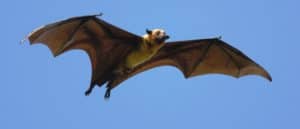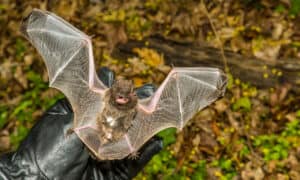Bats are a keystone species, meaning that they have an outsized impact on their environment relative to their abundance. They help maintain healthy ecosystems by controlling insect populations and aiding in the pollination of plants. In addition, many bat species serve as indicators for the health of ecosystems. If bats are declining, it is likely due to wider environmental issues that should be addressed. In the paragraphs below, we will cover ten bats in the U.S. that are endangered. This includes all territories of the U.S., like American Samoa and Guam.
Bats play a critical role in agriculture by consuming vast quantities of harmful insects such as crop pests. Additionally, some bat species act as natural pest control agents by eating mosquitoes and other disease-carrying insects like ticks.
Finally, certain types of “nectar” bats help spread seeds that aid plant growth across landscapes. This is especially important for maintaining tropical rainforests where over half the world’s biodiversity exists. Without bats, our planet would suffer greatly – yet these amazing creatures are currently facing rapid population declines due to habitat destruction and climate change. As we move into an uncertain future, it is essential that we take steps to protect these vital animals from further harm. We must ensure healthy ecosystems for generations to come.
1. Florida Bonneted Bat

The Florida bonneted bat is one of the largest bats in North America, with an average wingspan of 16-17 inches.
©Usha Roy/Shutterstock.com
The Florida bonneted bat (Eumops floridanus) is a vesper bat native to the southeastern United States. It is one of the largest bats in North America, with an average wingspan of 16-17 inches. However, it only weighs up to 1 ounce. Its fur is dark brown or black, while its ears are noticeably larger than those of other bats. They have two stripes running from each eye down the snout, giving it a “bonnet” appearance when viewed from above.
Currently, this species is endangered due to habitat destruction and alteration caused by human activities. These activities include urban development, agricultural expansion, and water management projects throughout Florida. Additionally, there have been cases of accidental mortality attributed to wind turbines and collisions with vehicles near foraging grounds.
Currently, fewer than 1000 individuals may live in the wild, which makes conservation efforts all the more important. Further research will benefit conservation efforts by helping us better understand their needs and how we can best protect them.
2. Gray Bat
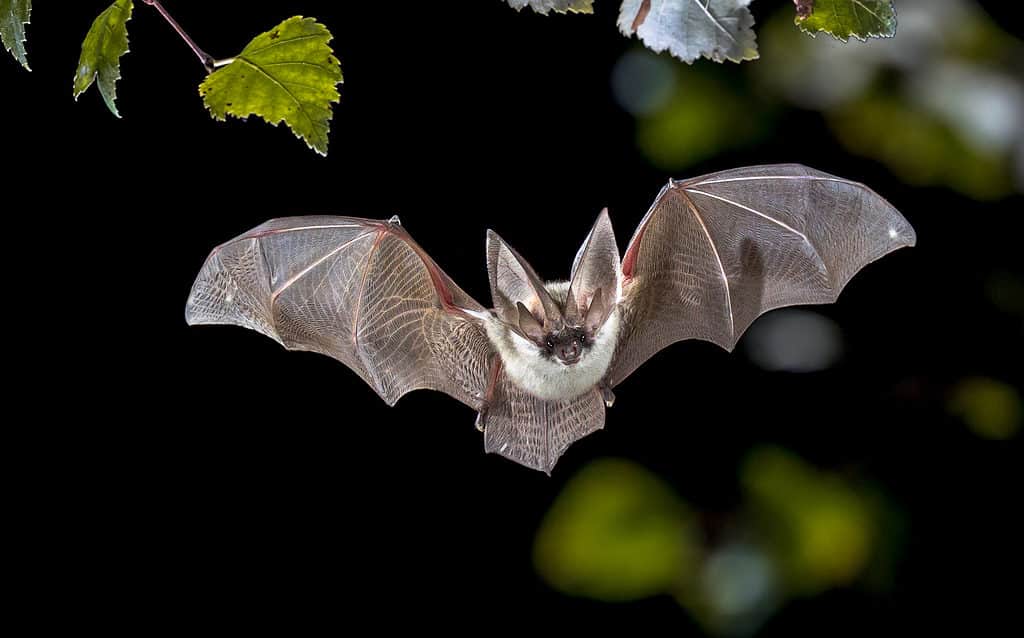
Not only is the gray bat fascinating to look at, but they are also vital members of their ecosystems as pollinators and insectivores!
©Rudmer Zwerver/Shutterstock.com
The gray bat (Myotis grisescens) has gray-brown fur that covers its head and body, with light-colored fur on its underbelly. Its wingspan can reach up to 11 inches, making it one of the larger bats in North America.
Not only is this bat fascinating to look at, but they are also vital members of their ecosystems. They act as pollinators and insectivores! They like to roost in large colonies during the day inside caves where there is ample humidity and ventilation.
Unfortunately, human development has led to many threats, including habitat destruction due to mining operations and cave disturbance. Pesticides used on crops near their habitats have also contributed significantly, leading some populations into decline over recent decades.
3. Hawaiian Hoary Bat

The Hawaiian hoary bat is known for its distinctive yellow collar under its chin and yellow ears trimmed with black.
©Photographer: Frank Bonaccorso, USGS / public domain – License
The Hawaiian hoary bat (Lasiurus cinereus semotus) is an endangered species found only in the Hawaiian Islands. This nocturnal mammal has unique, bright-colored fur that ranges from silver to gray. White tips and tufts of hair are near its face. It is known for its distinctive yellow collar under its chin and yellow ears trimmed with black. They have a wingspan of up to 18 inches, making them one of the largest bats in Hawaii. Their rounded ears are quite cute!
Unfortunately, due to human activities such as deforestation and poaching, there are now less than 1,000 left in the wild. The current threats to their survival are many and include habitat loss due to development projects and agricultural practices. These include grazing animals or planting non-native plants. They also suffer from cat predation, collisions with wind turbines, and climate change. The introduction of diseases from other mammals brought into the islands by humans is another large issue. In addition, increased ultraviolet radiation exposure due to ozone depletion is harmful to them. They also compete for food resources with invasive species like rats or mongooses.
4. Indiana Bat
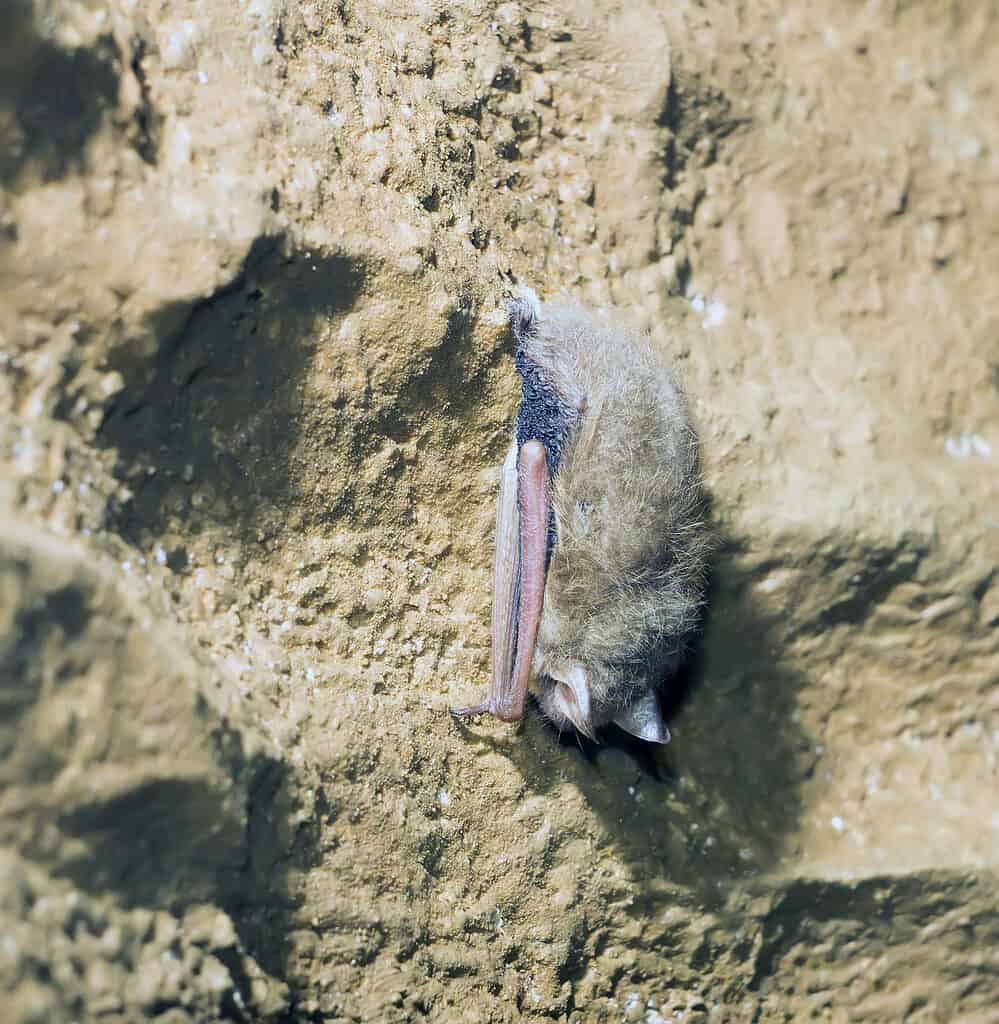
The Indiana bat’s fur is a dull grayish chestnut brown, and its underbelly is pink.
©IrinaK/Shutterstock.com
The Indiana bat (Myotis sodalis) is a cute little creature with a small body and short ears. Its fur is a dull grayish chestnut brown, and its underbelly is pink or rust-colored. It has a wingspan of 8-10 inches.
This species has been listed as endangered since 1967 due to habitat destruction and the use of pesticides in agricultural areas. There are currently only around 300,000 left in the wild, mostly located in Midwestern states like Indiana, Missouri, and Kentucky.
To save this species from extinction, humans must reduce their impact on habitats, which include caves, abandoned mines, and woodlands. Additionally, people should ensure they do not disturb hibernating colonies during winter when they are most vulnerable. Finally, any construction projects near potential bat habitats must be managed responsibly so that essential resources remain intact.
5. Mexican Long-nosed Bat
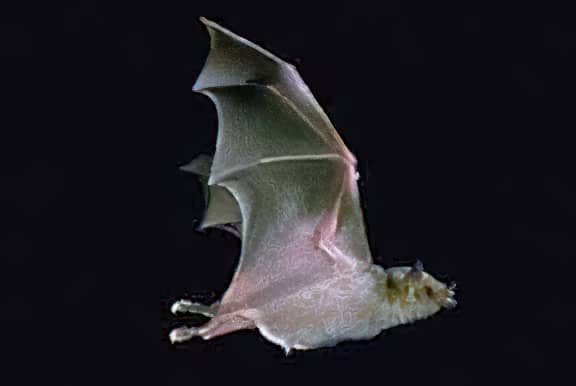
Mexican long-nosed bats are facing many threats from humans, such as habitat destruction caused by urbanization.
©Joelr31~commonswiki / public domain – License
The Mexican long-nosed bat (Leptonycteris nivalis) lives predominantly in the deserts and arid regions of Mexico and the United States. They have long snouts, which give them their unique name, as well as large ears that aid with their echolocation. These bats are cute due to their small size (half an ounce) and big eyes.
Unfortunately, this species is facing many threats from humans, such as habitat destruction caused by urbanization. Additionally, agricultural activities like deforestation are quite harmful. They are also threatened by climate change leading to reduced water availability in the areas where they live. There are only around 3800 individuals left in the wild across both Mexico and the United States combined.
6. Northern Long-Eared Bat
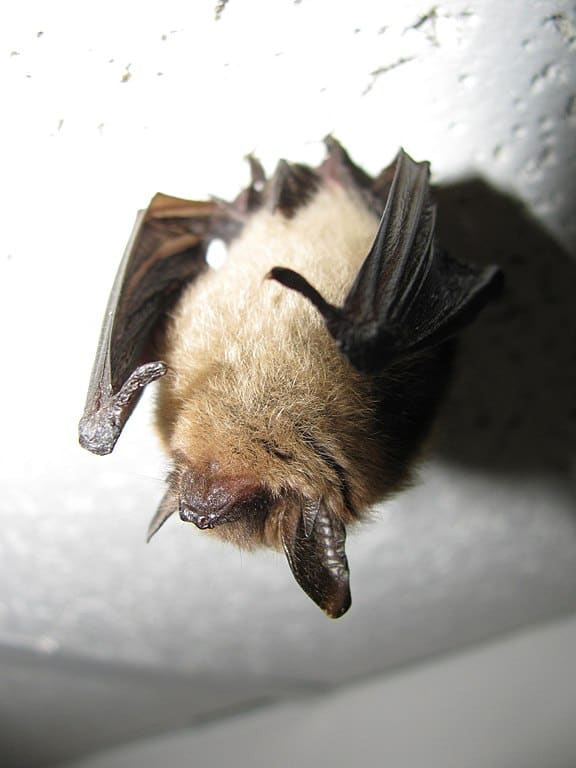
The northern long-eared
bat lives
in the Eastern half of the United States.
©Jomegat / CC BY-SA 3.0 – License
The northern long-eared bat (Myotis septentrionalis) measures 3 to 3.7 inches in length, and has a wingspan of 9-10 inches. Its fur color ranges from dark brown to light gray or cinnamon, with lighter-colored fur on its belly. It has large protruding ears and long legs for climbing trees and buildings.
Unfortunately, threats such as white-nose syndrome, a fungal infection, are causing a rapid decline in their numbers. Other threats are wind turbines, habitat destruction, pesticides, climate change, and human disturbance. In 2015, only about half a million were left in the wild across North America. This number is down from eight million before white-nose syndrome hit the bat population hard around 2006/2007.
7. Ozark Big-Eared Bat
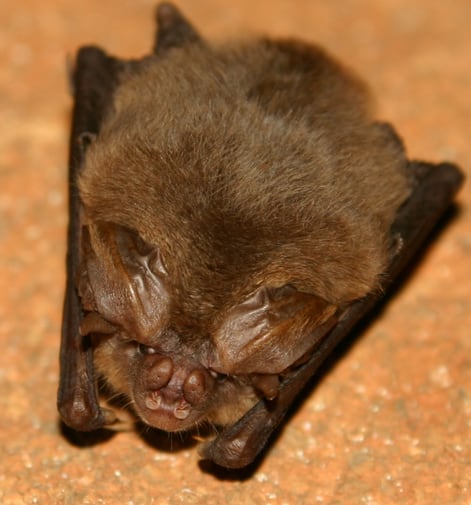
The Ozark big eared bat has distinct
white stripes
on the sides of its head.
© – License
The Ozark big-eared bat (Corynorhinus townsendii) is identified by its huge ears, which are up to three times larger than those of other bats. Its fur ranges from gray to yellow-brown and has distinct white stripes on the sides of its head.
Threats this species faces include habitat destruction due to human development and climate change. Additionally, they suffer from loss of food sources due to competition with other animals for limited resources. Currently, only about 2,000 individuals are left in the wild; however, conservation efforts have successfully increased their population over time.
Humans can help protect their remaining habitat by participating in reforestation projects and limiting activities that degrade or destroy habitats. These include clearcutting techniques or urban sprawl. Additionally, humans should be mindful when using pesticides near known roosting sites, as these can negatively impact populations.
8. Pacific Sheath-Tailed Bat – s. rotensis
There are two types of Pacific sheath-tailed bats that are endangered. The first is Emballonura semicaudata rotensis, a small, unique mammal found in Guam and the Northern Mariana Islands. It is an insect-eating bat with a wingspan of 9 inches. They are many shades of brown, with a lighter underbody. Their name refers to their short, narrow tail that comes from a sheath-like membrane.
Unfortunately, they are currently listed as critically endangered due to deforestation, habitat destruction, and disease caused by introduced species. At present, there are only approximately 500 individuals left in the wild.
9. Pacific Sheath-Tailed Bat – s. semicaudata
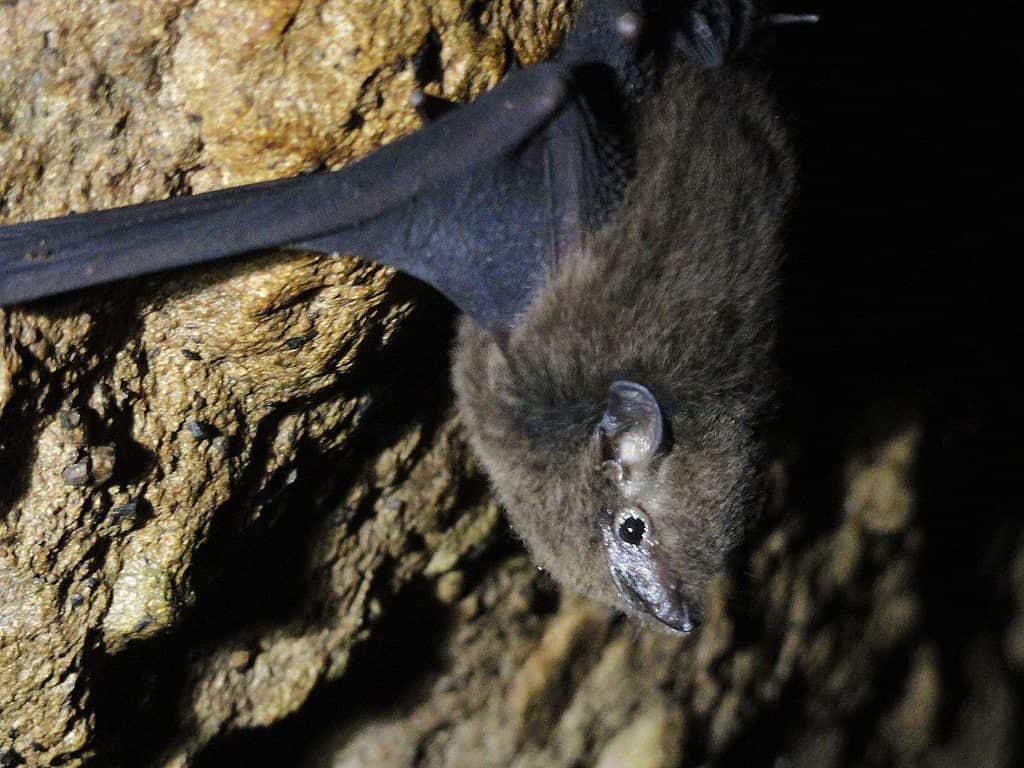
Pacific sheath-tailed bats are cave-dependent and roost in overhanging cliffs, crevices, lava tubes, and limestone caves.
©USFWS – Pacific Region / CC BY 2.0 – License
The second Pacific sheath-tailed bat (Emballonura semicaudata) is a small, furry brown creature with large ears and a unique tail. Their tail pierces the membrane, making its tip appear free on the upper surface.
They are cave-dependent and roost in overhanging cliffs, crevices, lava tubes, and limestone caves. These bats are nocturnal and emerge around dusk to forage for flying insects. They have historically been found in Samoa, American Samoa, Fiji, and Tonga. Surveys in 2008 and 2012 found no bats alive anywhere other than Fiji.
Unfortunately, these bats face threats from habitat loss due to human activities such as urban development and logging. In addition, they are also vulnerable to disease outbreaks such as white-nose syndrome, which has decimated many bat populations worldwide. It is estimated that there are fewer than 1000 individuals left in the wild, making them critically endangered. Conservation efforts must be taken soon to ensure these creatures don’t go extinct!
10. Virginia Big-Eared Bat

In addition to super-sized ears, this species has white hair on its belly and fur that extends beyond the ends of its toes!
©Larisa Bishop-Boros / CC BY-SA 3.0 – License
The Virginia big-eared bat (Plecotus townsendii virginianus) is an adorable species with a unique look. It has long ears, a grayish-brown coat, and white fur on its face and feet. In addition to super-sized ears, this species has white hair on its belly and fur that extends beyond the ends of its toes! The Virginia big-eared bat is incredibly cute!
Unfortunately, this species is in danger due to habitat loss from human development and the destruction of roosting sites. There are estimated to be fewer than 10,000 individuals remaining in the wild. Conservation efforts have been underway for years to help protect their habitats so they can continue to thrive.
What Can We Do to Save The Bats?
- Create corridors between fragmented habitats.
- Restore wetlands and riparian areas.
- Minimize pesticide use around roosting sites.
- Reduce vehicle speeds on roads in known habitats.
- Advocate for conservation efforts.
- Create safe roosting areas away from human activity.
- Preserve natural habitats.
- Support research to better understand population dynamics.
- Protect remaining natural habitats through reforestation.
- Reduce pollution levels caused by industrial activity.
- Control populations of invasive animals that prey on bats.
- Do not disturb bats in caves or abandoned mines.
- Do not disturb hibernating colonies during winter.
- Plan construction sites responsibly to protect bat habitats.
- Create education programs about their importance to local ecosystems.
- Create wildlife reserves and national parks dedicated to preserving endangered animals, like bats.
- Reduce emissions contributing to global warming.
- Implement sustainable agricultural practices.
- Introduce laws prohibiting the hunting or poaching of bats.
- Limit tree-clearing.
- Install acoustic monitoring equipment at wind turbines so bats can be diverted away safely.
- Preserve existing caves and crevices used as roosting sites for winter hibernations.
- Create artificial roosting sites for pregnant females who need undisturbed places for birthing colonies.
- Limit urban sprawl.
- Protect bats from logging and mining.
- Research how diseases spread so conservationists can better protect them.
A Summary of 10 Types of Bats in the U.S. That Are Endangered
- Florida bonneted bat
- Gray bat
- Hawaiian hoary bat
- Indiana bat
- Mexican long-nosed bat
- Northern long-eared bat
- Ozark big-eared bat
- Pacific sheath-tailed bat (1)
- Pacific sheath-tailed bat (2)
- Virginia big-eared bat
NEXT UP
- Why Are Tigers Endangered?
- 15 Endangered Species in Texas
- The 10 Most Endangered Species On Earth – And How To Help
The photo featured at the top of this post is © Rudmer Zwerver/Shutterstock.com
Sources
- U.S. Department of the Interior, Available here: https://www.doi.gov/blog/13-facts-about-bats
- U.S. Fish & Wildlife Service, Available here: https://www.fws.gov/story/bats-are-one-most-important-misunderstood-animals#:~:text=Conservation%20efforts&text=More%20than%2015%20bat%20species,under%20the%20Endangered%20Species%20Act.
- International Union for Conservation of Nature and Natural Resources, Available here: https://www.iucnredlist.org/search?query=bats&searchType=species
- U.S. Fish & Wildlife Service, Available here: https://www.fws.gov/species/gray-myotis-myotis-grisescens
Thank you for reading! Have some feedback for us? Contact the AZ Animals editorial team.



